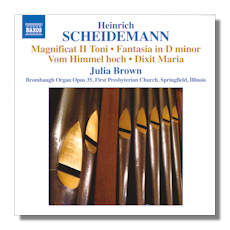
The Internet's Premier Classical Music Source
Related Links
- Scheidemann Reviews
- Latest Reviews
- More Reviews
-
By Composer
-
Collections
DVD & Blu-ray
Books
Concert Reviews
Articles/Interviews
Software
Audio
Search Amazon
Recommended Links
Site News
 CD Review
CD Review
Heinrich Scheidemann

Organ Works, Volume 7
- Magnificat II Toni, WV 15
- Fantasia in D minor, WV 83
- Courant and Variatio in D minor, WV 125
- Es ist gewisslich an der Zeit, WV 59
- Vom Himmel hoch da komm ich her, WV 69
- Courant and Variatio in F Major, WV 127
- Dixit Maria ad Angelum (after Hassler), WV 52
- Courant and 2 Variations in A minor, WV 130
- Praeambulum in D minor, WV 31
- Betrübet ist zu dieser Frist, WV 104
- Aus tiefer Not schrei ich zu dir, WV 2
- Mascherata in C Major, WV 109
- Praeambulum in E minor, WV 37
- A solis ortus cardine, WV 1
- Französischer Allemand in D minor, WV 114
- Courant & Variatio in D minor, WV 122
Julia Brown, organ
Naxos 8.573119
This is the seventh, and last, volume from Julia Brown on Naxos of all the organ works of the important, though sadly neglected, early Baroque composer Heinrich Scheidemann (c.1595-1663). It's well up to the standard of her earlier ones: Volumes 3 (Naxos 5.554548), 4 (Naxos 5.755876), 5 (Naxos 5.757054) and 6 (Naxos 5.73118) have all been very favorably reviewed here.
A handful of works, the Magnificat II Toni, WV 15 [tr.s 1-4], Es ist gewisslich an der Zeit, WV 59 [tr.s 7,8], Vom Himmel hoch da komm ich her, WV 69 [tr.s 9-11], Aus tiefer Not schrei ich zu dir, WV 2 [tr.s 17,18] and A solis ortus cardine, WV 1 [tr.s 21,22] demand our initial attention as being more substantial and perhaps worthy of greater admiration than the rest. Yet the other half of the CD is no mere "mopping up" operation by Brown. Each work deserves a place on the CD(s) in its own right and on its own terms.
One characteristic of Brown's playing is a measured reserve, stateliness or dignity that may mean for some that the pace of the playing sometimes lacks the spring which you might expect to hear in the progression of the summative passages of pieces like the Es ist gewisslich [tr.8] and Praeambulum [tr.20]. In other works, even though distance, almost pomp, is called for, something just a little livelier might have worked just as well. But Brown's playing has never a hint of the pedestrian or predictable. It's perhaps as though she feels she needs to wrap Scheidemann's music up in order to savor it. In fact it's robust enough in every way to stand on its own feet. Her approach would have been just as welcome had she allowed herself to deviate from what, to some, may seem like a rather "neutral" performance.
Overall, though, we're glad of the penetration and thoughtfulness of Brown's playing style. By acknowledging the clarity and detachment of Scheidemann's compositional style, her playing paradoxically draws us into his world. It also reflects the scope of Scheidemann's achievement and his authority in the North German school. Further, it shows the extent to which almost all of his work, though in many styles and using many genres, was tethered to, or at least arose out of, the Lutheran liturgy. At the same time, it must be remembered that Scheidemann was a pupil of Sweelinck; he inherited a love of dance, examples of which appear here too.
Yes, this is a varied selection of music. No one piece lasts more than about seven minutes; the bulk of them barely three. It could have been challenging to retain our interest over the 70 minutes of this CD. Yet Brown does. We are eager for what comes next. Scheidemann is a composer who was able to work in many styles: listen to the tunefulness and delight in the Courant with two short variations in A minor [tr.12], for instance. Brown picks up its contained mood; yet it's a mood which hints at a much wider and fuller world. The more substantial Dixit Maria [tr.13] is also a nice balance between the subdued and the devotional. But Scheidemann's confidence (with tonality and the gentle colors of the organ) again suggests a breadth with which Brown is fully in sympathy.
Brown plays the organ of the First Presbyterian Church in Springfield Illinois. It's a rich yet flexible instrument from 2004 by John Brombaugh from Eugene, Oregon. It has both sensitivity and power to stand behind the subtleties of Scheidemann's writing… passages of the second Verse of the Magnificat (WV 15) [tr.2], for instance, are very subdued and reflective. Other parts (Verses 1 and 2, in particular, of Vom Himmel hoch [tr.s 9,10]) of the composer's varied writing are sufficiently full of vigor that a more robust, though never overwhelming, projection is needed.
The CD comes with somewhat scant liner notes – a short essay by Brown describing the music in context, though set in a very small font; and details of the organ itself. The recording's acoustic is calm, spacious and has just the right amount of atmosphere to convey the vesy best of this wonderful music. If you've been collecting the series, you'll not want to miss this volume. If organ music from the generations before Bach intrigues, Scheidemann is a good place to start. Julia Brown's playing is more than merely competent. It's convincing, persuasive and full of expression. This series – and this CD in it – are strongly recommended.
Copyright © 2013, Mark Sealey


















